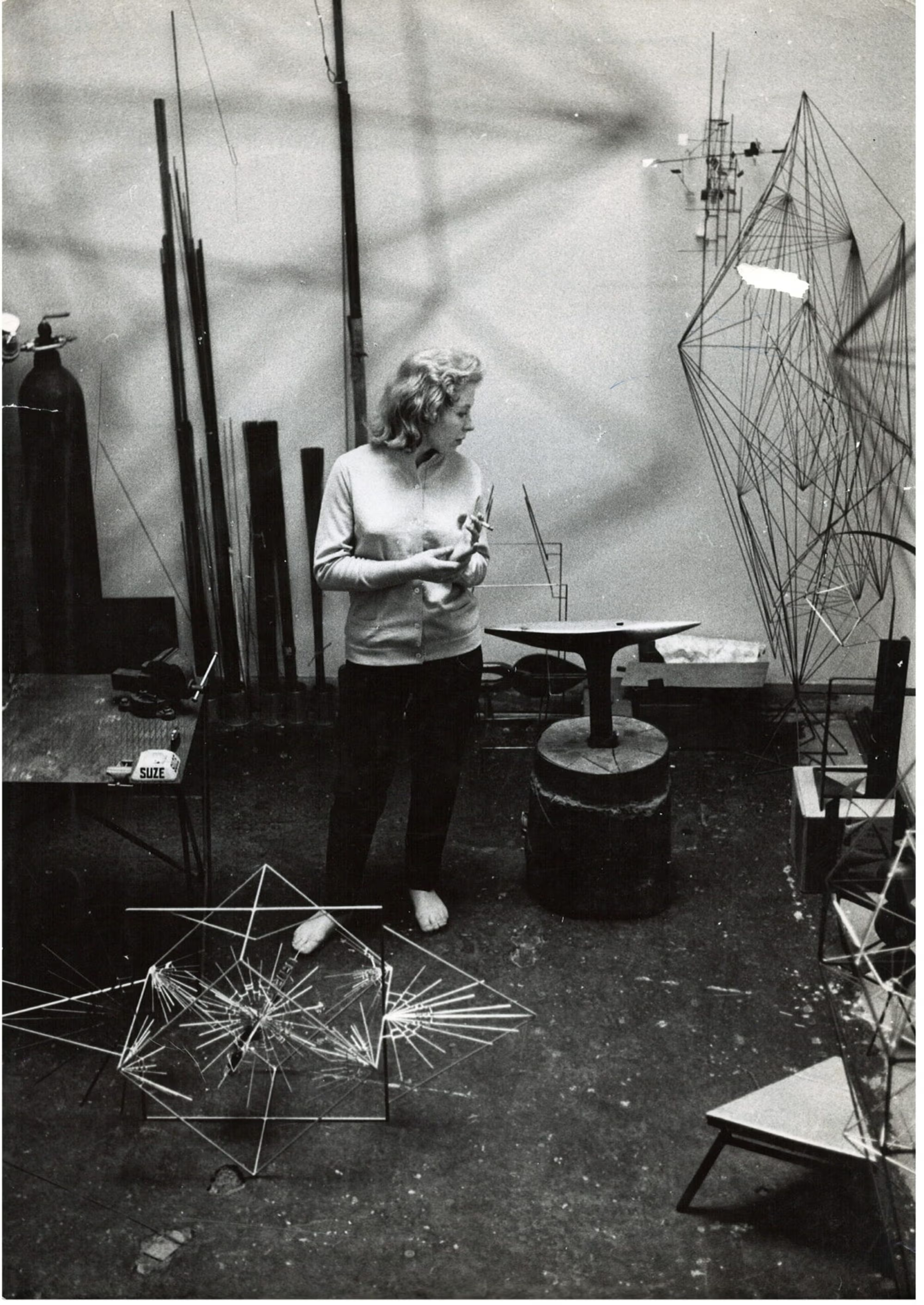Side by Side: Gerdur Helgadottir and Shinkichi Tajiri in the 1950s
- taneatajiri
- 11 aug
- 3 minuten om te lezen
Bijgewerkt op: 8 okt
While reviewing Shinkichi Tajiri’s archive, several early 1950s photographs surfaced of him working on plaster and iron sculptures in his Paris studio alongside another artist whose identity remained unknown until 2024. That year, curator Cecilie Gaihede of the Gerðarsafn Art Museum in Kópavogur contacted the estate for a loan request while preparing Transformation, an exhibition marking the museum’s 30th anniversary. Dedicated to the work of Gerdur Helgadottir, the show also included two of Shinkichi’s early iron pieces, Prisoner (1950–1952) and Scorched Earth (1955). Only later did we notice, in archival photographs, that these works appeared in the background of images of Gerdur working in the same studio.
Archival photographs of Gerdur Helgadottir, discovered in the personal archive of Shinkichi Tajiri.
To explore further, I traveled to Iceland with my parents to attend the exhibition’s opening, meet the curator and museum team, and conduct archival research. The museum generously shared its collection of Gerdur’s letters and photographs. Most movingly, the personal correspondence between Gerdur and Shinkichi, spanning from 1951 to 1970, was preserved at the National Library of Iceland. We were able to visit and read them at the last moment, an unexpected treasure.
Left: Shinkichi Tajiri with Family Group (1949). Photographer and date unknown.
Middle: Letter from Shinkichi Tajiri to Gerdur Helgadottir, 1951. National Library of Iceland.
Right: Gerdur Helgadottir in her studio. Photographer and date unknown.
After returning, I discovered even more letters and photographs in Shinkichi’s archive that we could now identify. Together, they form pieces of a history between two artists whose paths intertwined in the creative heart of post-war Paris.
Gerdur Helgadottir (1928–1975) was an Icelandic artist celebrated for her work in sculpture, stained glass, and mosaic. In 1949 she moved to Paris to study at the Académie de la Grande Chaumière, where, like Shinkichi and Ferdi, she became a student of sculptor Ossip Zadkine. Letters exchanged between Gerdur and Shinkichi reveal a friendship that lasted for many years and, at one point, developed into a romantic relationship. According to the publication Gerður from the Kópavogur Art Museum, the two met in the early 1950s, when Tajiri introduced Gerdur to the vibrant new ideas and artistic movements shaping post-war Paris.
In a letter to her parents dated April 25, 1951, Gerdur described meeting Shinkichi, who whisked her through the city on his motorcycle, introducing her to a network of artists. Through him, she met Iris Clert, owner of Galerie Colette Allendy, one of Paris’s most prestigious galleries. It was there that Gerdur held her first solo exhibition, with Tajiri assisting in every stage of preparation. As she recalled, “Tajiri got me the gallery, helped me transport the works, prepared the installation, found plinths for the works and assisted me in setting them up in the garden.”
Through Shinkichi, Gerdur also met Danish sculptor Robert Jacobsen and, shortly after her Paris debut, she purchased welding equipment and, like Shinkichi, learned the technique from Jacobsen. In letters home, she described spending Christmas in 1952 and 1953 with Tajiri and Jacobsen, whom Jacobsen affectionately called his “siblings.”

Left: Gerdur Helgadottir, Political Prisoner (1952-1953). Right: Shinkichi Tajiri, Prisoner (1950-1952).
Photo by Gerðarsafn Art Museum Kópavogur
In 1952, Gerdur entered a British Council competition for a monument dedicated to the unknown political prisoner. The following year, she received an award for her design Political Prisoner (1952–53) and was invited to exhibit it in London. Whether Shinkichi also entered remains uncertain, but his early iron sculpture Prisoner (1950–1952) bears striking similarities in size, material, and theme.
Studio shared by Gerdur Helgadottir and Shinkichi Tajiri, Paris, 1952–1956. Photographer unknown. Shinkichi Tajiri archive.
By 1955, Gerdur and Shinkichi were sharing tools and a studio on Rue Campagne-Première in Paris. Art historian Esa Sigurjónsdóttir has observed that their proximity is evident in the similarities between their surrealist sketches, plaster works, and early iron sculptures, all characterized by densely assembled structures cutting through space. Both show the influence of Spanish sculptor Julio González. Despite these parallels, their artistic voices remained distinct.
Photographs from 1956 capture the shared studio, with sculptures by both artists in view. Although they worked side by side for years, they never formally collaborated or exhibited together.

Contact sheet showing photographs of Gerdur Helgadottir in the shared studio on Rue Campagne-Première, Paris, 1956.
Visible on the wall are two versions of Shinkichi Tajiri’s Scorched Earth sculptures (1955) and several sculptures in the background. Photographer unknown.





















